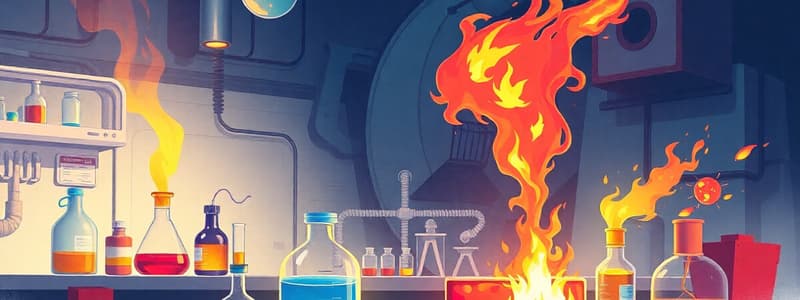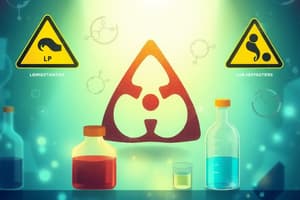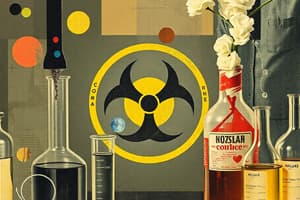Podcast
Questions and Answers
Which factor is LEAST important when minimizing radiation exposure?
Which factor is LEAST important when minimizing radiation exposure?
- Distance from the source.
- Time spent near the source.
- Air circulation in the room. (correct)
- Shielding between you and the source.
A Material Safety Data Sheet (MSDS) provides information about the safe disposal methods for a chemical.
A Material Safety Data Sheet (MSDS) provides information about the safe disposal methods for a chemical.
True (A)
According to the OSHA Hazard Communication Standard, what right do employees have regarding chemical hazards in their workplace?
According to the OSHA Hazard Communication Standard, what right do employees have regarding chemical hazards in their workplace?
Right to know
A substance that can cause cancer is described as being __________.
A substance that can cause cancer is described as being __________.
Match each hazard type to its corresponding description:
Match each hazard type to its corresponding description:
In the event of a fire in the laboratory, what is the first step outlined in the recommended procedure?
In the event of a fire in the laboratory, what is the first step outlined in the recommended procedure?
Electrical hazards are less dangerous in laboratory settings compared to other environments.
Electrical hazards are less dangerous in laboratory settings compared to other environments.
What is the immediate action that needs to be taken when encountering an electrical hazard?
What is the immediate action that needs to be taken when encountering an electrical hazard?
In the case of a fire, after rescuing individuals and activating the alarm, the next step is to ______ the fire by closing all doors to potentially affected areas.
In the case of a fire, after rescuing individuals and activating the alarm, the next step is to ______ the fire by closing all doors to potentially affected areas.
Match the actions to be taken during a fire emergency in a laboratory:
Match the actions to be taken during a fire emergency in a laboratory:
Which dilution of sodium hypochlorite is recommended for daily disinfection of sinks after discarding urine specimens?
Which dilution of sodium hypochlorite is recommended for daily disinfection of sinks after discarding urine specimens?
Biohazard sharp containers can be overfilled as long as they are puncture-resistant and leak-proof.
Biohazard sharp containers can be overfilled as long as they are puncture-resistant and leak-proof.
What is the immediate first aid procedure for skin contact with a chemical in the lab?
What is the immediate first aid procedure for skin contact with a chemical in the lab?
When mixing chemicals, acids should always be added to ______ to avoid splashing.
When mixing chemicals, acids should always be added to ______ to avoid splashing.
Why should acids always be added to water instead of water to acid?
Why should acids always be added to water instead of water to acid?
It is acceptable to pipette by mouth in the laboratory if proper care is taken.
It is acceptable to pipette by mouth in the laboratory if proper care is taken.
Which of the following is the most important reason for using a Plexiglas countertop shield when discarding urine into a laboratory sink?
Which of the following is the most important reason for using a Plexiglas countertop shield when discarding urine into a laboratory sink?
Match the following laboratory safety practices with their corresponding reasons or explanations:
Match the following laboratory safety practices with their corresponding reasons or explanations:
Which organization mandates safety procedure manuals in the analysis of urine and body fluids?
Which organization mandates safety procedure manuals in the analysis of urine and body fluids?
Urine can be disposed of in regular waste containers without any special biohazard precautions.
Urine can be disposed of in regular waste containers without any special biohazard precautions.
If an individual is exposed to a chemical hazard in the lab, which of the following injuries is possible?
If an individual is exposed to a chemical hazard in the lab, which of the following injuries is possible?
Exposure to ungrounded equipment or frayed cords can lead to an __________ hazard.
Exposure to ungrounded equipment or frayed cords can lead to an __________ hazard.
Match the type of safety hazard with its potential source:
Match the type of safety hazard with its potential source:
What is the primary purpose of standard precautions in a laboratory setting?
What is the primary purpose of standard precautions in a laboratory setting?
OSHA provides guidelines for writing safety procedures and policies in clinical laboratories.
OSHA provides guidelines for writing safety procedures and policies in clinical laboratories.
Which of the following is NOT a standard precaution?
Which of the following is NOT a standard precaution?
Besides infectious agents, name another source of biological hazards.
Besides infectious agents, name another source of biological hazards.
According to safety protocols, all biological waste, except ________, must be placed in containers labeled with a biohazard symbol.
According to safety protocols, all biological waste, except ________, must be placed in containers labeled with a biohazard symbol.
Flashcards
Hazardous Materials
Hazardous Materials
Substances that can cause harm. Examples include poisonous, corrosive, flammable, explosive, teratogenic, and carcinogenic materials.
MSDS Purpose
MSDS Purpose
An OSHA standard that requires employers to inform employees about chemical hazards in the workplace.
MSDS Information
MSDS Information
Physical/chemical characteristics, fire/explosion potential, reactivity, health hazards, safe handling/disposal, exposure limits, routes of entry.
Radiation Safety
Radiation Safety
Signup and view all the flashcards
Radioactive Area Signs
Radioactive Area Signs
Signup and view all the flashcards
Urine Disposal
Urine Disposal
Signup and view all the flashcards
Sink Disinfection
Sink Disinfection
Signup and view all the flashcards
Sharp Disposal
Sharp Disposal
Signup and view all the flashcards
Replacing Sharp Containers
Replacing Sharp Containers
Signup and view all the flashcards
Chemical Skin Contact
Chemical Skin Contact
Signup and view all the flashcards
Chemical Mixing
Chemical Mixing
Signup and view all the flashcards
Adding Acid
Adding Acid
Signup and view all the flashcards
Chemical Labeling
Chemical Labeling
Signup and view all the flashcards
Electrical Hazards
Electrical Hazards
Signup and view all the flashcards
Response to Electrical Hazard
Response to Electrical Hazard
Signup and view all the flashcards
Fire/Explosive Hazards
Fire/Explosive Hazards
Signup and view all the flashcards
RACE Acronym
RACE Acronym
Signup and view all the flashcards
Lab Personnel Responsibility
Lab Personnel Responsibility
Signup and view all the flashcards
Workplace Safety
Workplace Safety
Signup and view all the flashcards
CDC Role
CDC Role
Signup and view all the flashcards
OSHA's Purpose
OSHA's Purpose
Signup and view all the flashcards
Sharps Hazards
Sharps Hazards
Signup and view all the flashcards
Chemical Hazards
Chemical Hazards
Signup and view all the flashcards
Physical Hazards
Physical Hazards
Signup and view all the flashcards
Standard Precautions
Standard Precautions
Signup and view all the flashcards
Standard Precautions include
Standard Precautions include
Signup and view all the flashcards
Biohazard Waste Disposal
Biohazard Waste Disposal
Signup and view all the flashcards
Study Notes
- Identifying and mitigating potential hazards in work environments is important
- Components of the National Fire Protection Association hazardous material labeling system should be stated and interpreted
Learning Safety
- Working safely requires knowledge of existing hazards
- Working safely also requires knowledge of the basic safety precautions associated with hazards
- Understanding the application of common sense for patients, coworkers, and themselves is important
Organizations
- CDC: Centers for Disease mandates safety procedure manuals
- OSHA: Occupational Safety and Health Administration mandates safety procedure manuals
- CLSI: CLSI: Clinical And Laboratory Standards Institution provides the guidelines for writing the procedures and policies
Types of Safety Hazards and Injuries
- Biologic hazards: Infectious agents cause bacterial, fungal, viral, or parasitic infections
- Sharps hazards: Needles, lancets, and broken glass cause cuts, punctures, or are blood-borne
- Chemical hazards: Preservatives and reagents lead to exposure to toxic, carcinogenic, or caustic agents
- Radioactive hazards: Equipment and radioisotopes causes radiation exposure
- Electrical hazards: Ungrounded or wet equipment and frayed cords cause burn or shock
- Fire/explosive hazards: Open flames and organic chemicals cause burns or dismemberment
- Physical hazards: wet floors, heavy boxes, and patients cause falls, sprains, or strains
Biological Hazards
- These are signified by a specific symbol, usually a trefoil shape in yellow or green or a symbol representing a potential danger from biological substances
Transmission
- A susceptible host includes: The elderly, infants, immunocompromised patients, and anyone!
- Pathogens include bacteria, viruses, fungi and parasites
- Portal of entry includes the: mouth, nose, eyes, and cuts in skin
- Reservoirs consist of: People, animals, soil, food, water,
- The mode of transmission includes: Direct contact, indirect contact, and vectors
- The portal of exit consists of: Coughing/sneezing, bodily secretions, and feces
Breaking the chain of infection
- Breaking the link between infectious agents and susceptible hosts is usually best achieved through immunizations and healthy lifestyles
- Hand hygiene breaks the potential reservior link
- PPE (personal protective equipment), disinfection and sterilization of equipment breaks the portal of entry link
- By disinfecting and practicing hand hygiene you break the means of transmission link
- PPE, standard precautions and patient isolation breaks the portal of exit link
Standard Precautions
- Performing hand hygiene is included
- Wearing gloves is included
- Mouth, nose and eye protection are included
- A gown is important
- Patient care equipment standards are important
- Following environmental control standards are important
- Following linen handling procedures are important
- Considering occupational health hazards and blood-borne pathogens are important
- Patient placement when dealing with infections should be considered
- Respiratory hygiene / cough etiquette should be considered
Biological waste disposal
- Dispose of all biological waste, except urine, in labeled containers with the biohazard symbol
- Urine can be discarded in a laboratory sink under a Plexiglas shield, avoiding splashes, followed by flushing with water
- Disinfect the sink daily using a 1:5 or 1:10 dilution of sodium hypochlorite
Sharp Hazards
- Dispose of all sharp objects in puncture-resistant, leak-proof containers with the biohazard symbol
- Do not overfill biohazard sharp containers and always replace them when the safety capacity mark is reached
Chemical Hazards
- First aid for skin contact with chemicals is to flush the affected area with a large amount of water for 15 minutes and seek medical attention
- Only mix chemicals together if specific instructions are followed and must be added in the order specified
- Always add acid to water to avoid sudden splashing
- Pipetting by mouth is unacceptable in the laboratory
- Should be labeled with a description of their particular hazard(s) like: poisonous, corrosive, flammable, explosive, teratogenic, carcinogenic,
Material Safety Data Sheets (MSDS)
- OSHA Federal Hazard Communication Standard means all employees have a right to know about the chemical hazards present in their workplace
- Contained information includes: physical and chemical characteristics, fire and explosion potential, reactive potential, health hazards and emergency first aid procedures, methods for safe handling and disposal, primary routes of entry, exposure limits and carcinogenic potential
Radioactive Hazards
- Radioactivity may be encountered in the laboratory when procedures using radioisotopes are performed
- The amount of radiation exposure is related to a combination of time, distance, and shielding
- Display the radiation symbol on the doors of all areas where radioactive materials are present
Electrical Hazards
- In the event of an electrical hazard the electrical source must be removed immediately
- Turn off the power
Fire/Explosive Hazards
- Laboratory personnel should be familiar with these procedures:
- Rescue: rescue anyone in immediate danger
- Alarm: activate the institutional fire alarm system
- Contain: close all doors to potentially affected areas
- Extinguish/Evacuate: attempt to extinguish the fire, or evacuate
Studying That Suits You
Use AI to generate personalized quizzes and flashcards to suit your learning preferences.




